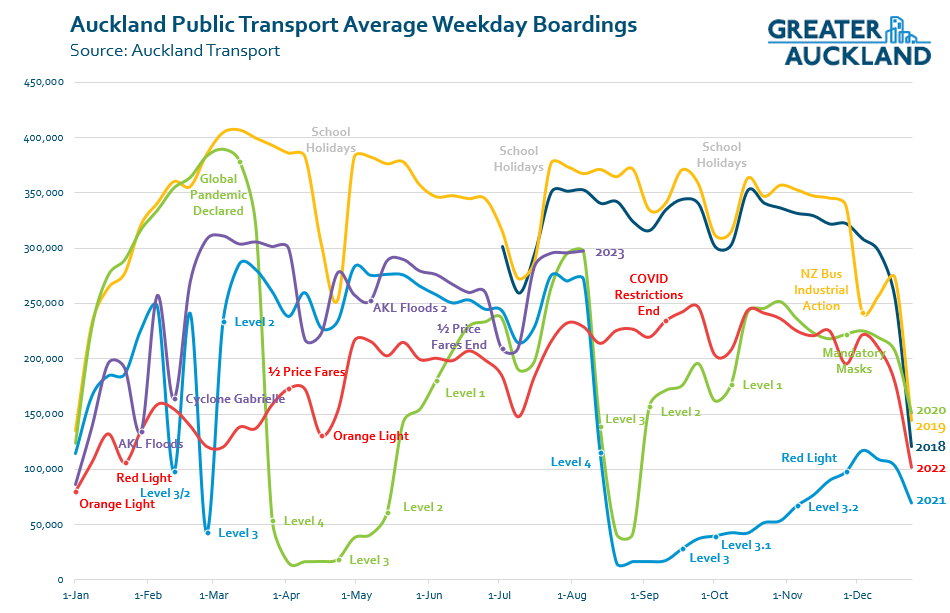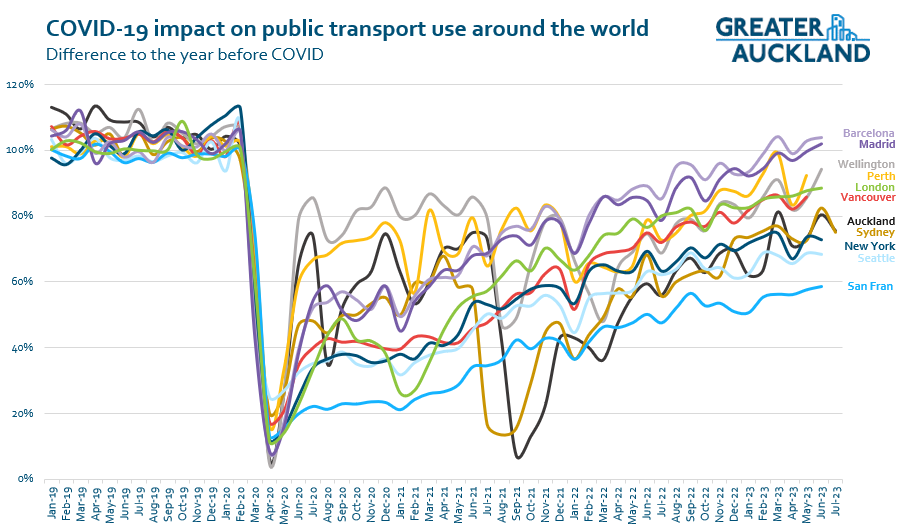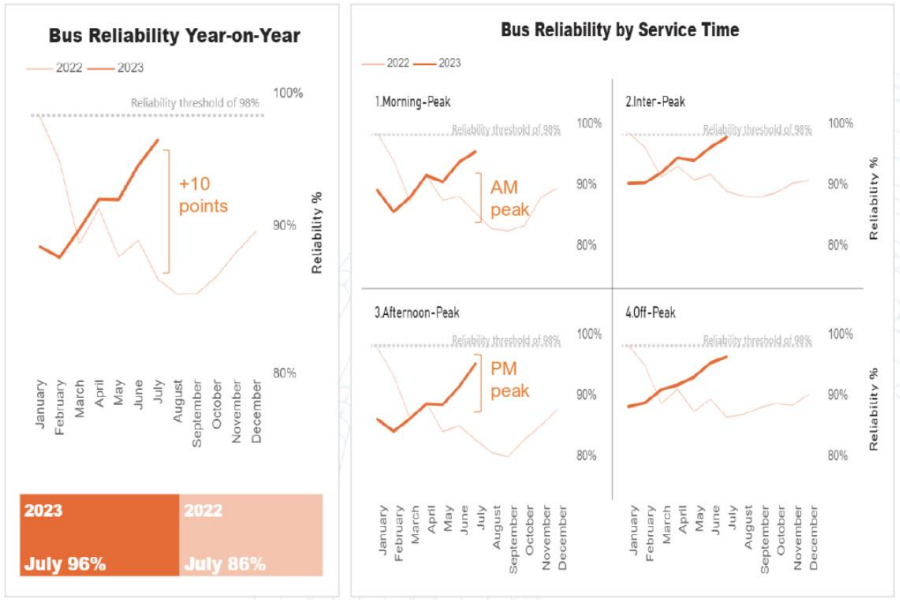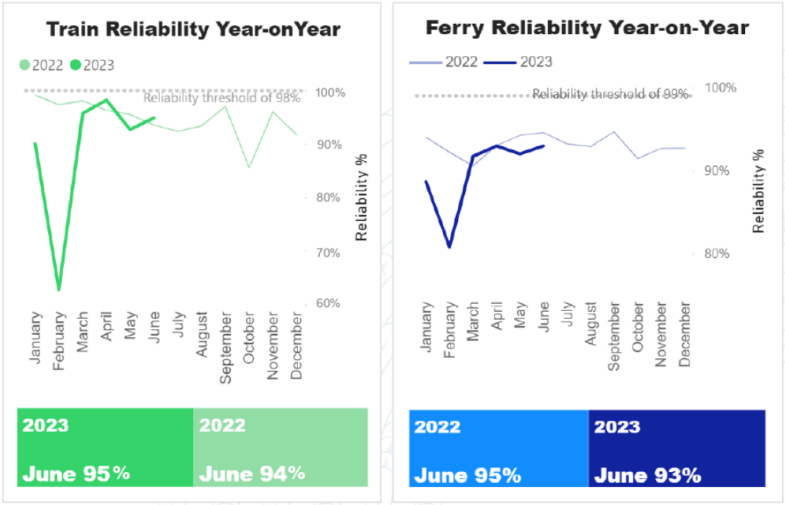Some good news from Auckland Transport yesterday that the bus driver shortage is officially over.
At the peak of the driver shortage just eight months ago, Auckland was 578 drivers short.
Auckland now has three more bus drivers than the required 2,306 to operate Auckland’s buses.
Richard Harrison, AT’s Metro Optimisation Manager says that for passengers, this means more buses and more reliability across Auckland’s bus network.
“We are extremely grateful for the patience of Aucklanders while we have worked hard to get our buses back to where they should be.
“We’re delighted that the bus driver shortfall is cleared – we now have more active drivers in the workforce than the full requirement, and there are more in training to build resilience.
“The operators have done an excellent job of attracting and retaining drivers over the last ten months, and it’s great to see passengers return as services become more dependable.”
Despite the challenges, Mr Harrison says Auckland’s public transport has bounced back strongly since COVID, with patronage at around 83% of 2019 levels.
“Our patronage recovery is on par or ahead of many places (the US is notably lower) and we are still working on ways to make public transport even more attractive to Aucklanders.”
Key information:
- Cancelled bus trips have been consistently below 3% over the past month.
- In July, all previously suspended buses were added back into timetables
- Bus driver shortfall is now resolved, with three more drivers in the workforce than the full requirement.
- Ferry skipper and deckhand shortfall remains at 25, with training and upskilling of the workforce due to start soon.
- Last week patronage was 1.72 million boardings, another week at the highest level since March. This is 83% of the comparative week in 2019.
This is great news, reliability is critical for giving people the confidence to use PT and the bus driver shortage resulted in thousands of services a day being cancelled at its peak, resulting in a significant impacts on bus users.
With buses now sorted, average weekday usage is up around 30% on last year and back to around 80% of pre-COVID levels,
Interestingly, weekend usage is now actually tracking slightly above what it was pre-COVID highlighting that weekday numbers are impacted by changes in working/commuting patterns. Many of these are of course in the city centre where AT focused much of it’s public transport attention pre-pandemic.
Looking at usage by mode, we can continue to see the impact of the rail network rebuild and significant ongoing reliability issues continue to be a major drag on usage. At a rough estimate, if rail use had recovered to the same level as buses, we’d be seeing an extra 20,000 PT trips per weekday, which would add around 6-7% extra total trips, putting us much closer to pre-pandemic levels.
It’s also interesting to see that the removal of half-priced fares doesn’t seem to have had any real impact on usage.
However, I’m not sure I fully agree with AT’s statement that “recovery is on par or ahead of many places”. Yes, we’re ahead of American cities but they’re typically not the best examples to compare ourselves to in the first place. I track a number of cities and while we’re tracking similar to Sydney, cities like Vancouver and London are in the high 80’s – where we’d be if our rail system wasn’t letting us down – others like Wellington and Perth are in the low-90s and cities in Spain are now ahead of pre-pandemic levels.
On the issue of disruption, in a report to the council’s Transport & Infrastructure Committee today, AT note:
- KiwiRail Rail Network Rebuild funding requirement increased to complete works following scope adjustment; initial advice is there is insufficient funding
- Risk to ferry services provision with training requirements.
Does this suggest were going to see the rail network rebuild drag on even longer?
And for ferries, this slide seems to suggest we’re about to see some service cancellations.
They also highlight reliability of each mode
Finally, it turns out AT have two different PT Satisfaction surveys and they give wildly different results.
AT explain that the first one uses a methodology prescribed by Waka Kotahi and is based on a paper survey taken quarterly by Gravitas onboard PT services that are running on time and anything 6+ out of 10 is classed as being satisfied. Meanwhile, AT’s online survey is smaller in scope but is more frequent, being taken weekly and done online. They say it reports 8+ out of 10 as being satisfied.
However, even if compared the same way, it seems the AT survey gives lower results.
The Waka Kotahi prescribed one seems out of touch to me.











 Processing...
Processing...
Mt Eden Road services are still only running every 10 mins at peak, vastly inferior to pre-2023 and comparible routes, and therefore still suffering overcrowding issues. Any news about whether this will be resolved soon?
A number of services have been cut since 2020, including on route 27 (Mt Eden Road). Is it reasonable to assume that those cuts are permanent?
I was wondering about that, too! 27T was cut due to driver shortage if I remember correctly. Not sure if they have all the drivers they need if they cannot reinstate these services.
My understanding from a post on the AT facebook either today or yesterday is that 27T is not coming back but will be replaced with additional 27W and 27H services
“Rather than reinstating 27T we have added more trips and more double deckers on 27H and 27W. The 27T travelled along the same route that is covered by the 27H or 27W (as can be seen in the map below). Feedback from residents of Hillsborough and Waikowhai was that we had too many 27Ts, which meant they had to wait a long time.”
That sounds like a good solution. I am not particularly invested in the 27T but more buses (or a tram/light rail) are desperately needed on that route.
Did they say when the additional services will be deployed?
Oh, they have added those already? Why are we still at 10 minute peak frequency?
Shame on me, I must have looked at the wrong time. It looks like there are 3 27* busses during each 15 minute period during peak, i.e. one bus every 7.5 minutes on average.
Yes I saw a 27* citybound on Mt Eden Rd yesterday morning (near Peary / St Leonards). Absolutely crammed to the gills.
> Ferry service had deteriorated over the past 24 months,
Yeah, well this appears to be going at a glacial pace, and I suspect will need a lot more work for any change….
https://nzta.govt.nz/assets/About-us/docs/review-of-the-exempt-status-of-fullers360-waiheke-ferry-service-consultants-report-november-2022.pdf
It is still unbelievable that the disruption of the KiwiRail Rail Network Rebuild will simply result in a better-built version of the previously-existing tracks. If KR did their job properly, they would use this series of year-long shutdowns to undertake four-tracking, grade separation, station upgrades, bridge work, resignalling and other projects that are infinitely easier to do when you’re not trying to run trains at the same time. Yes, it requires money, but most businesses refer to this as “investment”. It’s an indictment of the SOE model and will cost much more money in the long term as well as limiting the rail services that Auckland will be able to offer.
For an example of how to do it, see Melbourne: https://en.wikipedia.org/wiki/Level_Crossing_Removal_Project
Just getting consent to electrify Papakura to Pukekohe took months/years and that was “fast tracked” and mostly within the rail corridor. Imagine how long it would take to get consent for Eastern line 4 tracking?
One of the differences between motorways/roads and PT/active modes in NZ though is that whenever there’s new budget, the former tends to have a lot of “shovel ready projects”, while the latter tends to be starved not just of construction but also of design funding, so rarely has as many projects ready to go.
I mean, if National wins, and REALLY wanted to, they could probably start building East-West Link in 6mo or less. Compare that to starting work on a Northwestern Busway. Labour would be doing well (especially compared to their track record…) if they managed to start works on that before their next term (if they get one) is over.
Precisely. It’s really important to have a well-developed wishlist in preparation for good times. What would you build if you found $1billion behind the couch? What are the designations that you need to build a grade-separated, four-track, mixed-traffic electric rail line?
Obtaining money for rail improvements in New Zealand is like getting blood out of a stone. Look at the Northport rail spur. Despite being funded, designed and designated, it still has to go through an interminable business case. While these rules remain in place, it will be difficult to make the rail investments that we need.
https://www.stuff.co.nz/business/131715621/new-marsden-point-rail-link-one-step-closer-but-costs-still-not-revealed
Yes, and Bryn Gandy at the Future is Rail Conference told the audience that Councils wanting regional rail improvements would have to do all the planning required to pull together a good economic argument for it. This, apparently, would need to show the rail would serve economic growth along the route.
When the Ministry of Transport doesn’t accept that this planning should be being done centrally, nor that access for communities needs to be restored as a matter of equity, not on the basis of “economic growth” there’s little chance that Waka Kotahi will be doing any forward planning.
Similar situation for active modes. In addition, AT is quite good at burying the plans they do have. There were projects ready for delivery when the CERF and the Northern Pathway funding was available.
Just a reminder that AT’s “bus reliability” percentage is the proportion of routes which are STARTED within 5 minutes of the scheduled time. Nothing to do with reliability of picking up or dropping off passengers, nothing to do with arriving at any stop on time, nothing to do with completing the route as scheduled.
That’s good news.
Now would AT tackle the bus driver red light running problem? It seems to be at an all-time high. Vision Zero requires tackling this in a systemic way, moving responsibility upwards. AT has had 5.5 years since the Road Safety Business Improvement Review to get the contracts and relationships on track to tackle the problem.
Can we add to that the bus driver speeding problem? The AT safer speeds programme is great in principle, but in my area its worthless given the speed at which the rail replacement buses travel down the supposedly 30km/hr road…..
At the Transport and Infrastructure Committee yesterday, the head of safety explained, when discussing why the DSI “targets” are worse in the SOI than they were in last year’s (ie things are going downhill even faster now) that there’s not enough money.
Sigh. Neither she nor the rest of the ELT can see the thousands of ways for “how” they can use their money differently, it seems. Nor that car dependent planning is the most expensive approach and we can have better safety on a smaller budget.
Those ferry cancellations? Complete removal of the Birkenhead, Northcote and Bayswater services for a year and a half apparently. So anyone on a bike now… can’t.
And they buried it behind “great news”! Unbelievable.
Great news re the bus drivers. Those surveys are useless if you ask me, only those with a strong opinion and not given up on improving things at all would bother doing them.
Interesting re that 27 Mt Eden route…of course light rail be good on there.
Today’s post
“The Ferries are F*****”
its telephone service and continue to stand out in the competitive airline industry.
I want to go to your place as a driver, is it possible?
Coach Builders India is a leading platform dedicated to the bus industry in India. Since its launched, it has become a trusted source for news, insights, and analytics, aiming to support the industry’s growth and modernization. This platform serves as a critical resource for industry stakeholders, offering coverage and analysis to help navigate the evolving bus transportation landscape in India.